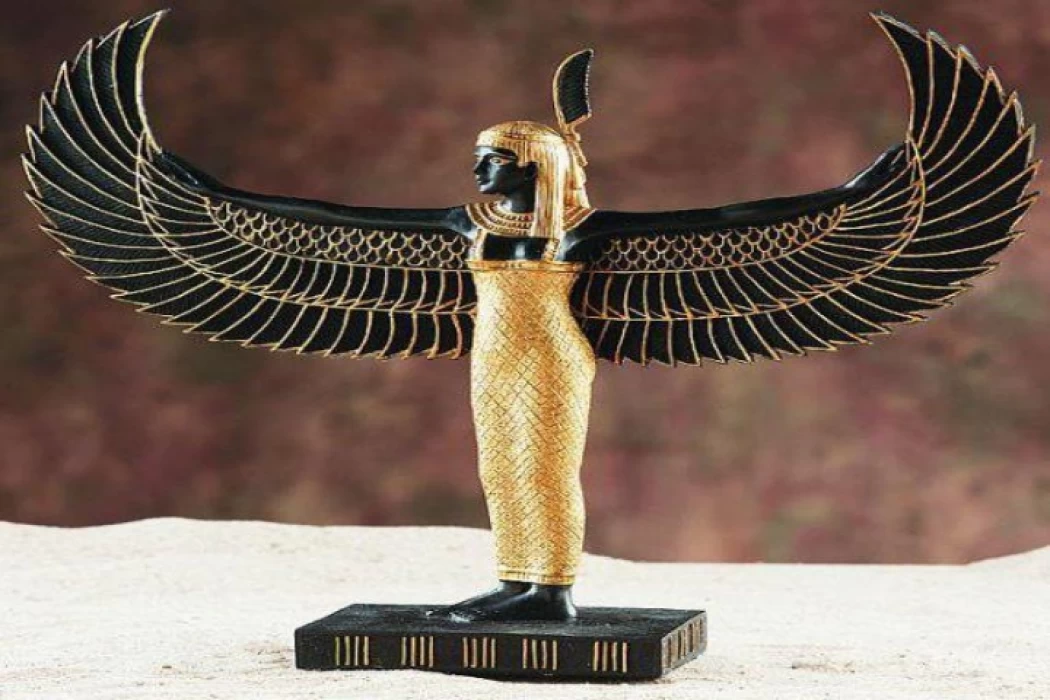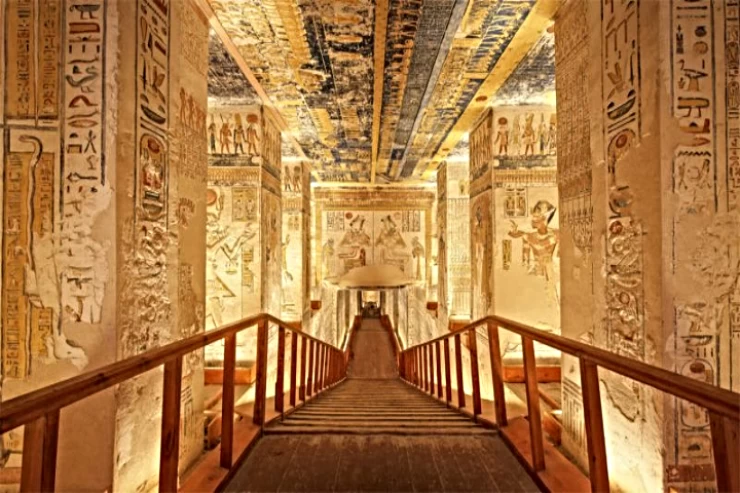
Ma`at dea nell'antico Egitto
Ma`at dea nell'antico Egitto
Dea Ma`at secondo l'antica religione egizia lei è una dea della verità e della giustizia, Ma`at è la figlia del dio Re e moglie di Thout dio della conoscenza Dea Ma`at rappresentata in forma femminile con piume di struzzo sopra le sue teste e che tiene l'Ankh che significa la chiave della vita e l'altra mano che tiene la mazza
Nel mondo sotterraneo degli antichi egizi, il cuore dei morti veniva posto sulla bilancia da un lato e la piuma della dea Maat dall'altro. Se il cuore del defunto si inclinava, sarebbe entrato in Paradiso nelle loro credenze, ma se la piuma si fosse gonfiata, sarebbe entrato nell'Inferno, che era rappresentato dalle antiche credenze egiziane sotto forma di un immaginario mostro predatore di nome Amamut, la cui testa è la testa di un coccodrillo e il suo corpo è il corpo di un leone e la sua schiena è il corpo di un ippopotamo. La corte negli inferi era composta da 42 giudici, il numero di regioni dell'Egitto, guidate da Osiride.
La concezione degli antichi egizi nel Giorno del Giudizio era che Anubi avrebbe accompagnato i morti in aula e i giudici avrebbero iniziato a interrogare il defunto sulle sue azioni in questo mondo, e se stava seguendo il Maat (la strada giusta) o se era tra i peccatori. E il defunto inizia a difendersi e dice: non ho ucciso nessuno, non ho denunciato una persona, non mi sono lamentato di un operaio con il suo capo, e non ho rubato. E stavo dando da mangiare ai poveri, e mi sono stati dati dei vestiti agli ignudi, ho aiutato le persone e ho usato per dare l'acqua assetata. Quindi i giudici iniziarono a chiedergli della sua conoscenza degli dei, quindi dovette menzionare gli dei con i loro nomi e fare attenzione a non dimenticarne uno.
L'offerta (Maat) è uno dei tipi più importanti e più importanti di offerte che i re desideravano rappresentare nei templi a causa del suo significato e della sua grande importanza. Il sacrificio di "Maat" conferma la missione del re di ottenere l'ordine (Maat) sulla terra e di soddisfare gli dei. [4]
Il concetto di "Maat" era il sistema standard esatto per tutto, che rappresenta la base del mondo e tutto ciò che corrisponde agli scopi della divinità Creatore. Quindi, è imperativo per gli esseri umani preservarli e approvarli e ripristinare "Maat" e il sistema alla sua condizione adeguata se è esposto a qualsiasi difetto o disturbo. E poiché la visione egiziana del maat come l'essenza e l'elemento materiale su cui vive il mondo intero, e come un potere per gli dei e per i vivi e i morti tra gli umani, i "testi delle bare" menzionavano che gli dei vivono su (Maat) , e gli dei approvarono "Maat" sulla terra, e la sua approvazione era su. La terra è responsabilità del re, che rappresenta gli dei tra gli uomini, e vive come essa su (Maat).
L'offerta di "Maat" riassume in una forte forma simbolica tutto ciò che si intende per adorazione e sacrifici offerti agli dei, e tutti i rituali del servizio quotidiano nei templi e le offerte offerte. Pertanto, un tempio egizio non è quasi privo della scena del sacrificio del "Maat" nelle varie iscrizioni, scene religiose e scene di offerta e rituali.
Era necessario che il re riconoscesse il "Maat" sulla terra, e questo era incarnato nella presentazione del re dell'offerta di "Maat" agli dei come metafora per stabilire l'ordine e la giustizia, e qualunque cosa gli dei volessero. Il re lo presentava quotidianamente agli dei come prova tangibile del suo essere un loro rappresentante nel suo ufficio divino nel quadro di (Maat).
Il "sacrificio di maat" indica che la missione del re è raggiungere il "maat", il che significa che il sacrificio qui è una metafora o un'espressione simbolica per completare il compito di cui il re è responsabile. Sebbene molti testi indichino che sia gli dei che il re fanno rivivere il "Maat" in senso morale più che in senso sacrificale, e che la divinità e il re si nutrono solo del "Maat" come verità che viene detta, e il giustizia stabilita.
Il sacrificio di Maat è apparso dal Medio Regno, anche se non è apparso dopo fino al regno del re Thutmose III. La scena (l'offerta del "Maat") è stata registrata nelle iscrizioni delle pareti della maggior parte dei templi egizi, e in essa il re è mostrato in piedi di fronte alla divinità e gli ha presentato il simbolo di "Maat" nella sua mano o su una nave. E il sacrificio di "Maat" avrà la forma di una piccola statua della dea "Maat", la dea della verità, della giustizia e dello stretto ordine cosmico, seduta con una piuma di "Maat" sulla sua testa, e in la sua mano è il segno della vita. In rari casi, troviamo la presentazione della sola piuma "Maat", e che era nel tempio di "Seboua" al re "Ramses II".
Tra i templi in cui è apparsa la scena del sacrificio di "Maat": il tempio "Amon-Ra" a Karnak (in numerose scene del regno del re "Thutmose III", di fronte a numerose divinità); E il tempio "Aton"
Il nostro team vi aiuterà a viaggiare in Egitto e sperimentare il tempo soleggiato del nostro bel paese durante la Pasqua 2024, grazie alla loro vasta conoscenza del turismo egiziano. Puoi personalizzare il tuo pacchetto selezionando uno dei nostri pacchetti di viaggio in Egitto o sfruttare al massimo il tuo tempo in una breve visita, imparando di più sulla storia egiziana e le sue affascinanti storie e vivendola attraverso tour privati al Cairo. Partecipa a uno dei nostri tour economici in Egitto attraverso il deserto del Sahara, come i tour di Siwa dal Cairo, per esempio, o preferibilmente i tour nel Deserto Bianco d'Egitto. Scoprite i nostri tour di un giorno ad Assuan, fate una gita di un giorno da Assuan ad Abu Simbel, o viaggiate via terra e godetevi i nostri tour di un giorno a Luxor per vedere gli incredibili templi di Karnak, il Tempio di Luxor, il Tempio di Hatshepsut, e vedete le meravigliose tombe splendidamente dipinte nella Valle dei Re, questo è il luogo dove i re e i governanti del nuovo regno riposano in pace e imparate i loro riti di mummificazione e sepoltura.
Ma`at Goddess in Ancient Egypt
Goddess Ma`at according to ancient Egyptian religion is a goddess of truth and justice, Ma`at is the daughter of Re god and wife to Thout god of knowledge Ma`at goddess represented in women form with ostrich feather above her head and holding the Ankh which means the life key and the other hand holding the mace
In the underworld of the ancient Egyptians, the heart of the dead were placed on the scales on one side and the feather of the goddess Maat on the other side. If the deceased’s heart tilted, he would enter Paradise in their beliefs, but if the feather swelled, he would enter Hell, which was represented by ancient Egyptian beliefs in the form of an imaginary predatory monster named Amamut, whose head is the head of a crocodile and his body is the body of a lion and its back is the body of a hippo. The court in the underworld consisted of 42 judges, the number of regions of Egypt, headed by Osiris.
The 42 Laws of Maat: Ancient Egyptian Society's Ethical Underpinnings The fundamental tenets of justice and morality in ancient Egypt were established by the 42 Laws of Maat.
The conception of the ancient Egyptians on Judgment Day was that Anubis would accompany the dead to the courtroom, and judges would begin to question the deceased about his actions in this world, and whether he was following the Maat (the right path) or was he among the sinners. And the deceased begins to defend himself and says: I did not kill anyone, I did not expose a person, and I did not complain about a worker with his boss, and I did not steal. I was feeding the poor, and I was given clothes to the naked, and I helped people, and I used to give the thirsty water. Then the judges began to ask him about his knowledge of the gods, so he had to mention the gods by their names and beware of forgetting one of them.
To the pharaohs, Ma'at was represented as a goddess with an ostrich feather on her head, a symbol of justice. The goddess held the key of life, Menkh, in one hand and a scepter in the other, symbolizing balance. She was credited with controlling the seasons and the movements of the planets and stars.
The Cult of Maat
While the cult of Maat was more than limited, the respect she commanded was, however, boundless. For maat (justice) was always a cornerstone of social balance. Respect among humankind, in particular, ensured a measure of salvation. A salvation that Maat would appreciate during the final judgment rendered by Osiris. "To speak according to Maat" meant to speak the truth. At the Last Judgment, the heart spoke according to Maat and could not lie. Upon death, no deceased could avoid the trial of the Last Judgment.
There, the weight of good and evil accumulated in each person's heart was calculated. Thus, the deceased who had lived with justice and kindness would be assured of having their heart compared to Maat, to their advantage. It was during psychostasis (the "weighing of the soul") that everything concerning their future in the afterlife was decided. Maat as a principle was created to meet the complex needs of the emerging Egyptian state, which embraced diverse peoples with conflicting interests. The development of such rules sought to avoid chaos, and Maat became the basis of Egyptian legislation.
The concept of "Maat" was the exact standard system for everything, which represents the basis of the world, and everything that corresponds to the purposes of the Creator deity. Hence, it is imperative for humans to preserve and approve them, and to restore "Maat" and the system to its proper condition if it is exposed to any defect or disorder.
And since the Egyptian view of the maat as the essence and material element upon which the whole world lives, and as a power for gods and for the living and the dead among humans, the "Coffins Texts" mentioned that gods live on (Maat), and the gods approved "Maat" on earth, and its approval was on The land is the responsibility of the king, who represents the gods among men, and lives like it on (Maat).
















